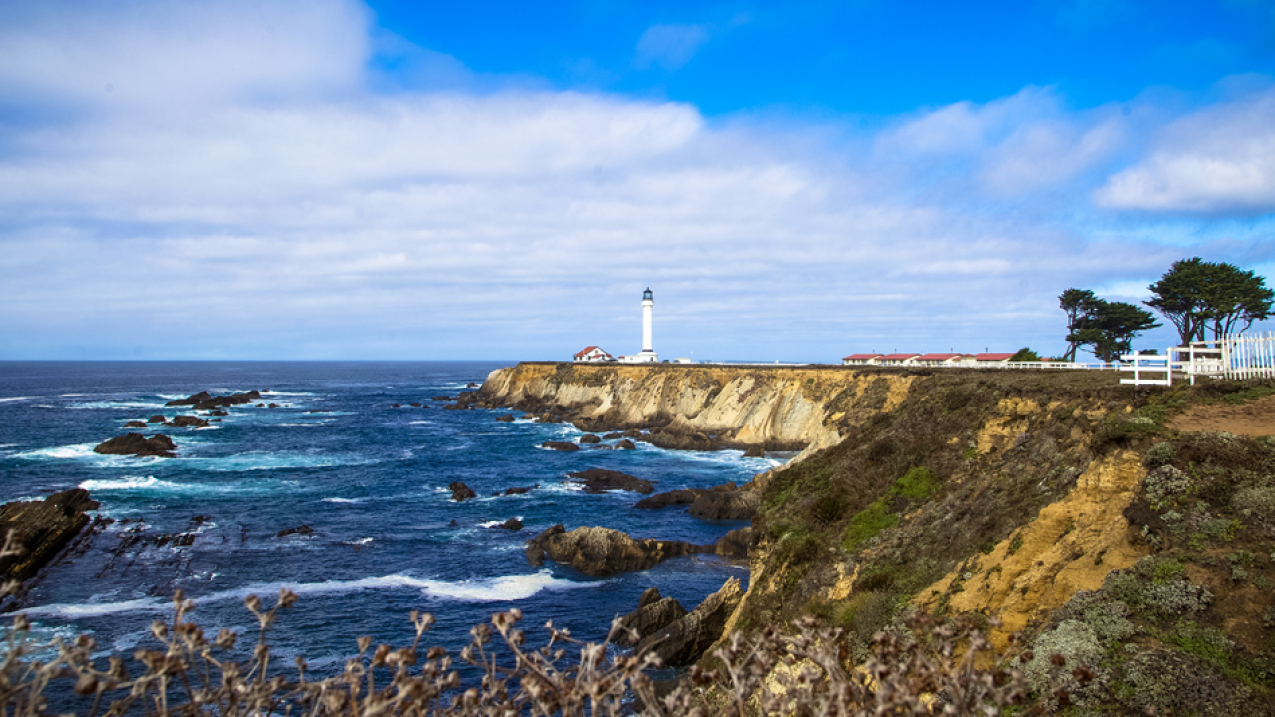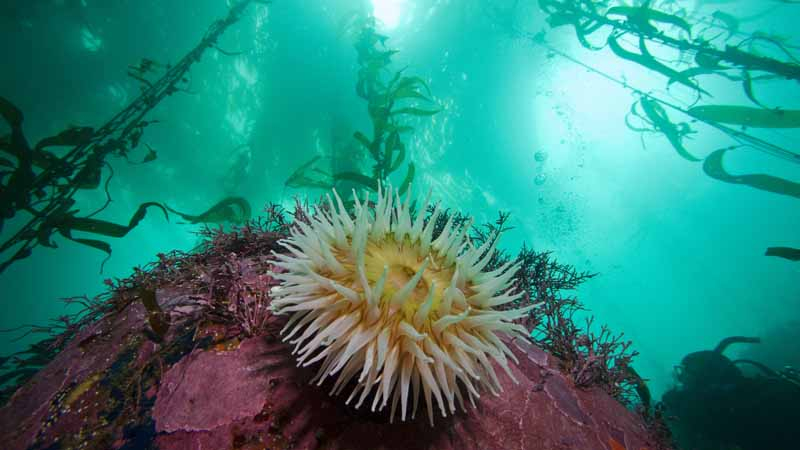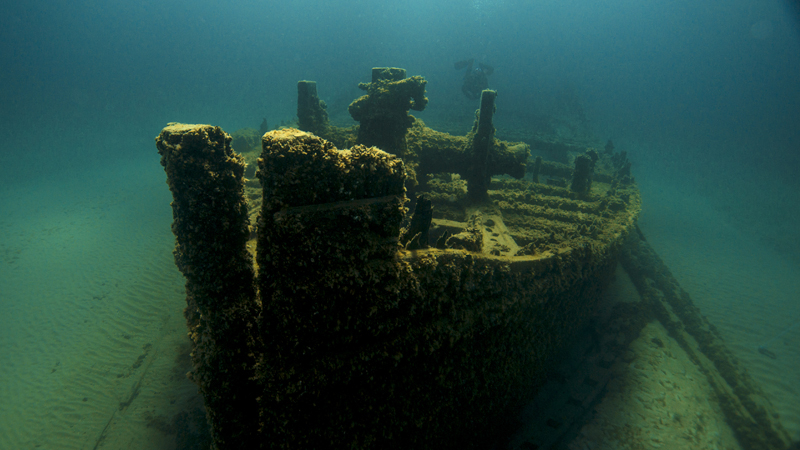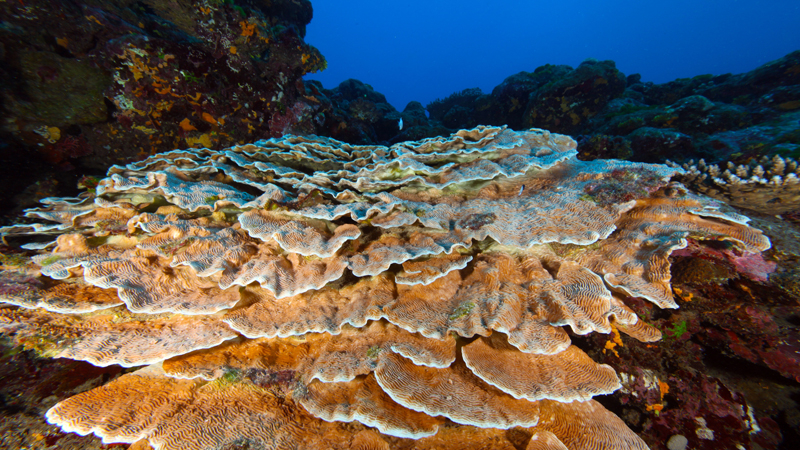
The Point Arena lighthouse watches over the northern part of Greater Farallones National Marine Sanctuary. Greater Farallones expanded in 2015 to encompass more than 3,000 square miles off the coast of California, including the rich upwelling zone that originates off of Point Arena and flows south. (Image credit: NOAA/Matt McIntosh)
How does NOAA designate a national marine sanctuary?
What is a sanctuary?
How is a sanctuary nominated?
How is a marine sanctuary is designated?
The four steps to designation of a National Marine Sanctuary
How to get involved in your national marine sanctuary
Marine sanctuaries include beautiful rocky reefs, lush kelp forests, whale migration corridors, spectacular deep-sea canyons and underwater archaeological sites.
Our nation's marine sanctuaries provide a safe habitat for species close to extinction and protect historically significant shipwrecks. Ranging in size from less than one square mile to 582,578 square miles, each sanctuary site is a unique place requiring special protections.

More than 600,000
—Square miles of marine and Great Lakes waters NOAA manages as national marine sanctuaries and monuments
NOAA invites communities across the nation to nominate their most treasured places in our marine and Great Lakes waters for consideration as national marine sanctuaries.
In 2014, NOAA launched a new, locally driven sanctuary nomination process, developed with input from more than 18,000 public comments. When local communities nominate an area to be a sanctuary, NOAA is available throughout the process to answer questions and provide guidance to communities and other interested parties. NOAA also updates nominators on the progress of the agency’s review of their nomination. The process is described in detail at http://www.nominate.noaa.gov/.

Nomination is the first step toward designating a sanctuary. After a potential sanctuary is nominated, it enters into the designation process, which includes a high level of public input and often takes several years to complete. Learn more about sanctuary designations at http://sanctuaries.noaa.gov/management/designations.html.
Under the National Marine Sanctuaries Act, the Secretary of the Department of Commerce, NOAA, and the U.S. Congress are authorized to designate marine areas as national marine sanctuaries. The act requires extensive public process, local community engagement, stakeholder involvement and citizen participation, both prior to and following designation.
Once NOAA accepts a sanctuary nomination, designating a new national marine sanctuary has four further steps: scoping, sanctuary proposal, public review and, finally, sanctuary designation.

Public input is key. Before a sanctuary is designated, the public, agency partners, tribes and other stakeholders provide input on the sanctuary proposal. NOAA considers all input and determines appropriate changes to the proposal.
NOAA identifies areas to consider for national marine sanctuary designation through the community-based sanctuary nomination process. Nominations that successfully complete the process are added to an inventory of areas NOAA could consider for designation.
The process for designating a new national marine sanctuary has four steps:
Scoping: NOAA announces its intent to designate a new national marine sanctuary and asks the public for input on potential boundaries, resources that could be protected, issues NOAA should consider and any information that should be included in the resource analysis.
Proposal: NOAA prepares a draft designation, including a draft management plan, draft environmental impact statement that analyzes a range of alternatives, proposed regulations and proposed boundaries. NOAA may also form an advisory council to help guide the proposal and focus stakeholder participation.
Public review: The public, agency partners, tribes and other stakeholders provide input on the draft documents. NOAA considers all input and determines appropriate changes.
Sanctuary designation: NOAA makes a final decision. Before the designation becomes effective, the governor of the state hosting the new sanctuary and the U.S. Congress review the decision.
Two areas in Maryland and Wisconsin rich in history are under consideration to become national marine sanctuaries. These areas contain a combined collection of 239 known shipwrecks spanning from the Revolutionary War through the present, and one site contains the remains of the largest "Ghost Fleet" of World War I.
National marine sanctuary volunteers have the opportunity to participate in a wide variety of activities including diving, whale identification, beach cleanups and water quality monitoring.
They conduct field observations and surveys, monitor wildlife, and act as visitor center docents. Sound interesting? Learn more about volunteering opportunities around the nation and in your backyard.

In 2014, sanctuary volunteers contributed over 140,000 hours to the sanctuary system, equal to $3.15 million (using the non-profit organization Independent Sector’s 2014 estimated value of volunteer hours). In addition, 5,886 of these volunteers specifically supported citizen science efforts helping to answer real-world scientific questions with a total of 63,084 hours.
Marine sanctuaries include beautiful rocky reefs, lush kelp forests, whale migration corridors, spectacular deep-sea canyons and underwater archaeological sites.
Our nation's marine sanctuaries provide a safe habitat for species close to extinction and protect historically significant shipwrecks. Ranging in size from less than one square mile to 582,578 square miles, each sanctuary site is a unique place requiring special protections.

More than 600,000
—Square miles of marine and Great Lakes waters NOAA manages as national marine sanctuaries and monuments
NOAA invites communities across the nation to nominate their most treasured places in our marine and Great Lakes waters for consideration as national marine sanctuaries.
In 2014, NOAA launched a new, locally driven sanctuary nomination process, developed with input from more than 18,000 public comments. When local communities nominate an area to be a sanctuary, NOAA is available throughout the process to answer questions and provide guidance to communities and other interested parties. NOAA also updates nominators on the progress of the agency’s review of their nomination. The process is described in detail at http://www.nominate.noaa.gov/.

Nomination is the first step toward designating a sanctuary. After a potential sanctuary is nominated, it enters into the designation process, which includes a high level of public input and often takes several years to complete. Learn more about sanctuary designations at http://sanctuaries.noaa.gov/management/designations.html.
Under the National Marine Sanctuaries Act, the Secretary of the Department of Commerce, NOAA, and the U.S. Congress are authorized to designate marine areas as national marine sanctuaries. The act requires extensive public process, local community engagement, stakeholder involvement and citizen participation, both prior to and following designation.
Once NOAA accepts a sanctuary nomination, designating a new national marine sanctuary has four further steps: scoping, sanctuary proposal, public review and, finally, sanctuary designation.

Public input is key. Before a sanctuary is designated, the public, agency partners, tribes and other stakeholders provide input on the sanctuary proposal. NOAA considers all input and determines appropriate changes to the proposal.
NOAA identifies areas to consider for national marine sanctuary designation through the community-based sanctuary nomination process. Nominations that successfully complete the process are added to an inventory of areas NOAA could consider for designation.
The process for designating a new national marine sanctuary has four steps:
Scoping: NOAA announces its intent to designate a new national marine sanctuary and asks the public for input on potential boundaries, resources that could be protected, issues NOAA should consider and any information that should be included in the resource analysis.
Proposal: NOAA prepares a draft designation, including a draft management plan, draft environmental impact statement that analyzes a range of alternatives, proposed regulations and proposed boundaries. NOAA may also form an advisory council to help guide the proposal and focus stakeholder participation.
Public review: The public, agency partners, tribes and other stakeholders provide input on the draft documents. NOAA considers all input and determines appropriate changes.
Sanctuary designation: NOAA makes a final decision. Before the designation becomes effective, the governor of the state hosting the new sanctuary and the U.S. Congress review the decision.
Two areas in Maryland and Wisconsin rich in history are under consideration to become national marine sanctuaries. These areas contain a combined collection of 239 known shipwrecks spanning from the Revolutionary War through the present, and one site contains the remains of the largest "Ghost Fleet" of World War I.
National marine sanctuary volunteers have the opportunity to participate in a wide variety of activities including diving, whale identification, beach cleanups and water quality monitoring.
They conduct field observations and surveys, monitor wildlife, and act as visitor center docents. Sound interesting? Learn more about volunteering opportunities around the nation and in your backyard.

In 2014, sanctuary volunteers contributed over 140,000 hours to the sanctuary system, equal to $3.15 million (using the non-profit organization Independent Sector’s 2014 estimated value of volunteer hours). In addition, 5,886 of these volunteers specifically supported citizen science efforts helping to answer real-world scientific questions with a total of 63,084 hours.


